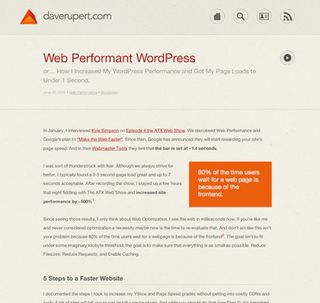How to keep people on your website
Expert tips to increase your site's 'stickiness'
Getting the design and content right are key when making your site sticky, but so too are technical factors. If your site is slow to load, users might not even bother waiting, no matter how much amazing content it contains.
Assuming this hurdle is overcome, ongoing speed must be maintained to hold a user's interest. "The longer people stay, the more engaged they'll become, ultimately increasing the chance of their desire to return," says Bluhalo's Steve Clarke.
Strike a balance
But remember that web design is a balancing act – don't get spooked and rip out or oversimplify your content in the name of stickiness. "People are willing to wait for something, within reason," points out Bustarde.
"For instance, most people don't mind that Netflix's online movie player takes a minute to load, because they're expecting to be with the site for hours." However, at the other extreme, the same wait for 30 seconds of content would be a poor experience.
Fields also recommends that designers resist temptation to shove 'sticky' hooks above the fold. "Thanks to long scrolling sites such as Facebook, people are no longer afraid to scroll," he says. "Sometimes, telling a story and creating pacing on a page is good. Just as stories have conflict, climax and resolution, why shouldn't a website sometimes use that same convention?"

One shouldn't underestimate users, argues Fields, and warns against confusing a short attention span with the notion that users don't want content. "The important thing is to ensure that content throughout your sites is of a high quality – that, ultimately, ensures users will be willing to wait, engage and return. Speed and pacing are especially important for mobile sites, although 'sticky' in the mobile domain rarely equates to 'more time' – instead, less is more in this space.
Get daily insight, inspiration and deals in your inbox
Sign up for breaking news, reviews, opinion, top tech deals, and more.
"Keep things simple," recommends Code Computerlove founder Louis Georgiou. "Have content targeted for the device it's consumed on, remove noise and visual clutter, keep options relevant and obvious, and make things light and quick," he says.
Hefendehl agrees, suggesting sites offering quick access to important information to ensure return visits. "A bad example is Transport for London's site, which loads too much content when accessed via a smartphone," he says. "By contrast, National Rail offers exactly what you need on the go, allowing easy access to train times and destinations."

Whether on the desktop or mobile, fast sites demonstrably lead to increased stickiness, which can in turn increase revenue. ZURB's Bryan Zmijewski explains that the agency has seen revenue bumps on ecommerce sites of up to 30 per cent simply by making pages load faster.
Speed testing
Objectively measuring a site's speed is fairly simple, thanks to modern tools. Clarke recommends Firebug, which "provides a list of how long each element takes to load, helping to identify those causing delays and enabling you to focus on improving specific content load times."
Hosting provision also plays an important role in delivering good speeds. "Load testing will give you an idea of the capacity of your servers," he says. "A poor result indicates that the server needs to be optimised or that additional server capacity is needed."
Sometimes, this can pay rapid dividends. For example, Hefendehl explains how Pod1 upped the number of UNIQLO UK servers for Christmas, to cope with increased demand, and the resulting site speed bump helped conversion rates rise by 50 per cent. Unsurprisingly, UNIQLO subsequently decided to retain this server setup.

Unfortunately, measuring how site speed affects visitor engagement isn't always as straightforward. "Many analytics tools recommend placing code at the bottom of a page, but on slow sites the tool may miss the fact someone's even visited," says Bustarde.
"For sites you know are going to have a relatively long load time, one possibility is to let your analytics tool track when a visitor first arrives and then treat their first action on the site as a sort of mini conversion."
Hefendehl also argues that measuring a site's stickiness differs depending on its business objectives. "It could be time on site; it could be returning visitors per campaign; it could be number of transactions; it could be cost per acquisition," he suggests. "There's no general rule for measuring this."
To that end, don't be too reliant on time-based feedback alone: in fact, says Chudley, doing so can be dangerous. "You can get a skewed impression of site success," he points out. "A client once delighted in telling me that user visits averaged over 20 minutes. In reality, his service should have led to short visits but the site was hard to use and people were getting stuck…"

Ideally, look for a range of indicators when judging the stickiness of a website, and make them relevant to the site. If the site is designed to offer quickfire information, look for short visits with people returning regularly. If the site aims to keep people engrossed for hours, ensure that's what's happening.
If you're providing interesting content for people to grab, the tracking of downloaded files in tandem with return visits and growth might be enough to indicate a site's success regarding stickiness.
"This will all change from site to site, but should detail whether visitors are doing what you expect," says Bustarde. Having stickiness as your overriding goal requires the strategy of proving value.
In the end, what some visitors find useless and trite, others will find essential. It's your job as a designer to aim the right content at the intended audience – and to ensure that everything sticks.











